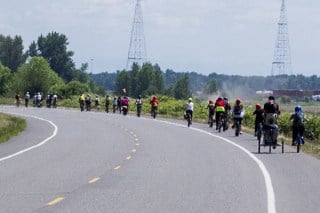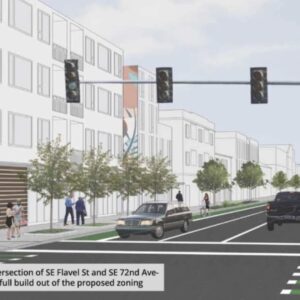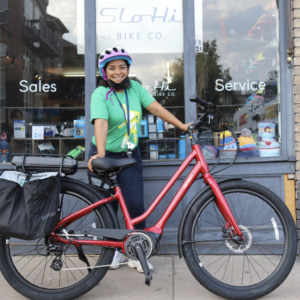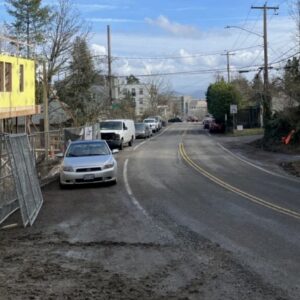
to ride along Lower River Road.
(Photos: Todd Bachmann)
This story was written by our Vancouver correspondent, Madeleine von Laue.
Bicycle activists in Vancouver are organizing a ride with elected officials along Lower River Road this Friday (8/23). The ride is an attempt to raise support for a project that would complete the path along the high-speed road that connects downtown with popular recreation areas west of town such as Vancouver Lake and Frenchman’s Bar along the Columbia River. The Port of Vancouver recently received a federal grant to construct one segment of the path, and advocates want to build on that momentum.
“This is a community driven ride to showcase the importance of this trail to Vancouver’s health and outdoor recreation potential,” said ride organizer Todd Bachmann. Currently, funding for the complete 3.7 mile trail is pegged to development and could take 15-25 years to materialize. “We’re asking our state representatives to help find grants and other money to accelerate the project’s completion.”
Lower River Road is the westward funnel for several major arterials, including Mill Plain and Fourth Plain boulevards leading from downtown, and it parallels the Columbia. It offers views of and access to some of the region’s best recreational and nature sites. And it’s an ideal route for cycling and running. But the road runs through a growing industrial area, and with a 50 mph posted speed limit and a steady stream of big rigs, garbage trucks heading to the landfill, pickups, vans and other traffic, it is unpleasant and unsafe for non-motorized users. (See a Google Map of Lower River Road created by The Oregonian.)

“The route shouldn’t be just for elite runners and cyclists,” said Bachmann. “Kids and families and older adults need to feel safe and comfortable riding out there. It has tremendous potential to help Clark County citizens get outside and be more active, and it addresses a priority of our county officials to make our community healthier.”
“The route shouldn’t be just for elite runners and cyclists. Kids and families and older adults need to feel safe and comfortable riding out there… and it addresses a priority of our county officials to make our community healthier.”
— Todd Bachmann
The port also recognizes the assets a trail along the road would provide. “The port’s ongoing efforts to construct the multi-modal pathway are grounded in its mission to provide economic benefit to our community…,” according to a recent news release about the project from the port. With approximately 2,300 people currently employed by businesses at the port and an expected additional 2,000 employees in the next five to 10 years, the port is also well aware that a path connecting the port to the city’s residential areas and the C-Tran bus service is a crucial part of a strong transportation system.
The Port is proposing a 12′ path separated from traffic by trees and other landscaping. A .5 mile section was completed last year (see photo above), and the new grant will allow the port to complete another .5 mile section.
“This is a very expensive project,” said Katy Brooks, Community Planning and Outreach Manager for the Port. “It crosses major wetlands and several sections have multiple owners. We’ll also need to widen the road.” The total project is estimated to cost about $2.5 million.
A number of local and state officials have RSVP’d for the event, including Representatives Jim Moeller and Ann Rivers, Vancouver Mayor Tim Leavitt, Vancouver City Council members Larry Smith and Bill Turlay, and council member candidates Anne McEnerny-Ogle and Alisha Topper.
Organizers are encouraging the community to join the ride. Participants will meet at 1:00 pm at 2121 St. Francis Lane (map). The ride will be an easy three miles, and the event is expected to end before 2:30. For more information, see the BikeVanWa blog.





Thanks for reading.
BikePortland has served this community with independent community journalism since 2005. We rely on subscriptions from readers like you to survive. Your financial support is vital in keeping this valuable resource alive and well.
Please subscribe today to strengthen and expand our work.
Thanks for contributing Madeleine, and many thanks to you and other folks in Vancouver for the effective advocacy. I can’t make the ride this Friday, but I wish I could be there!
Yes Todd, Madeleine and her Couv gang do deserve thanks. In fact, an extra measure of thanks for having to deal the mallwalkers who dominate so much of the thiking north of the river.
Ah, when I lived there it was one of my favorite places to be harassed by drivers, er, I mean, to time trial.
One problem I’ve seen in a few places where ‘bike trails’ were put in is that it becomes assumed that cyclists should no longer be riding on the road (or shoulder). For people like myself, who consider this road a great place to do intervals or try to hold a 25 MPH speed, the last place I’d want to do that is on a MUP with dog-walking pedestrians and people chatting away on their cell phones. I hope improvements in this area focus on safety buffers between varying speeds/modes and not just on ‘getting bikes off the dangerous road.’
In my new home they just added another sidepath that narrows the road shoulder, adds huge concrete walls to keep peds/bikers safe from errant cars (that you can’t see over at intersections where you merge back with traffic), and bends around a high-traffic corner before dumping you into traffic at 90 degrees (because, you know, you’re supposed to walk your bike across crosswalks). In summary, all I can say is that I hope any improvement where you are is planned and implemented by people who understand bicycle traffic flow.
It’s nice to see movement on this project. I hadn’t heard anything about it until a month ago when I decided to add a few extra fun miles onto my commute home one morning. On my way back from the lake I saw the MUP and though what an odd little random MUP out here.
Nice work, folks. Problem identified, solution proposed, now shine some light on the issues and hopefully you’ll get some political action.
Textbook case, you’re doing it right. Should get results.
Ted Buehler
BTW, you don’t need to be a Vancouver or Washington Resident to provide political support for this project. If you reside in another jurisdiction, but feel unsafe riding a bike on Lower River Road, you still have every right to speak and be heard with regard to road improvements. Roads are designed, built, maintained and improved for the benefit of all who travel them , not just those that live within the political boundary of the entity that owns them.
Vancouver City Council contact info — http://www.cityofvancouver.us/citycouncil/page/meet-your-mayor-city-council
Would you be more likely to ride up there and have dinner afterwards if they built this trail sooner? Let them know.
Ted Buehler. Former Vancouver resident
Madeleine, Todd, what do you think. Any downside risk to this?
To non-residents providing comments? I don’t think so. It is something of a destination for some cyclists, but many of those folks might looking for training opportunities like Pete mentions. Still, there are lots of family destinations out along that route that will be much more accessible for everyone, not just residents, when they build the trail.
Todd, Ted, Pete: absolutely right; the route is used by a lot of cyclists and others, not just locals, and their support is needed. A separated trail will get kids, families and recreational users off the road so time-trial and other athletics can take the road without worrying about slower users.
At the Bicycle Alliance of WA we’re delighted to be collaborating with BikeVanWa, Bike Clark County and others to improve the bike networks in the area. I was just in Vancouver 8/18 for Sunday Streets Alive and everyone I talked with was thrilled about that event and the growing support for bicycling.
I’d agree that out-of-town voices are valuable in support of any project. In fact, we’re expanding our work as the statewide bike advocacy organization to include promotion of bike travel and tourism, both because it gets people riding and because the value to a local economy of “wallets on wheels” can be very compelling to elected officials, both local and state. We know that the infrastructure developed that might be justified to create a tourist attraction is serves the people who already live there every single day.
If you’re from somewhere else and say that a complete system would entice you to vacation in Vancouver instead of somewhere else, you’re speaking a language that matters to decision makers. Safe, comfortable bike networks make strong towns for those who live there at the same time they make them more attractive travel destinations. Let them know!
Amen Pete. Getting bikes off roads and onto MUP shouldn’t be the focus or be deemed a solution for all cyclists.
I’m totally confused how placing a MUP that crosses all the commerical/industrial driveways is better than keeping bikes on the proper side of the street for traffic flow.
As a cyclist, I want to ride with traffic, in a safe and predictable fashion. By placing both directions of bike traffic in the south side of Lower River Road, it puts bikes headed westbound (toward the lake and Frenchman’s Bar) on the “wrong” side of the road. From the placement of the existing path, drivers (especially large trucks) will come up to **and stop on** the MUP in order to place their vehicles in the proper placement to see traffic on LRR and to negotiate their turns. It seems that will effectively cause cycling traffic to stop frequently if trucks are entering or exiting any of the businesses on the south side of LRR.
I’ll stay on the westbound shoulder. In 15 years of riding LRR, I’ve never had an issue with a driver when riding LRR in the direction of traffic.
Ayla, this push for the trail is not focused to be a solution for all cyclists or to move all cycling traffic to that path. The messaging behind this campaign has been clear about that. There are advanced riders who can navigate the small shoulder and traffic. We’ve always been aware of that. They can continue riding on the west side. The push is to make the NW Lower River Road accessible to the widest amount of riders possible given the path’s location. It’s a great lure to get people on their bikes and maximize the city’s recreational opportunities – start in downtown Vancouver and 5 miles later you’re at the beginning of two great natural space. Plus it’s ideal for many people to try biking to work if they work on the Port campus, especially with their new Centennial Industrial park. There are several neighborhoods nearby or they could take a bus to the intersection of 4th and Mill Plain and bike the rest of the way.
The one thing that could improve for advanced riders that prefer to ride with the traffic on the shoulder, and this is in our sites, is to routinely clean the debris off the shoulders for advanced riders like yourself.
All in all, it seems safe to say you know how to ride effectively to minimize risk on the road, which isn’t the case for every bike rider.
Also, the separate MUP path on the west side is the best of what’s available. We asked a lot about building something on the west side of the road, because we felt having a trail on the west side would be much more idyllic given it’s adjacency to the wetlands. However, due to the port’s industrial footprint, most of the land east of the road is protected wetlands to compensate for the Port’s development. Also the land on that side is owned by several different parties. Given those two things, it would be very hard to find a way to mitigate the already mitigated wetland area and very expensive to even double the width of the shoulders for road riders like yourself.
It is our understanding that the Port needs to provide alternative transportation solutions when they build new infrastructure. Plus we at BikeVanWa feel it makes good business sense for the Port to offer bike lanes to their property to stay competitive. The Port also owns most of the land on the west side of NW Lower River Road and they had plans to build the path. Trying to build something in addition to their project on the west side, especially with the very high price tag, makes it next to unfeasible. So we’re working with the Port to make sure the community can benefit from their MUP project as much as possible.
There will be trucks turning left into Port property, which isn’t ideal. But once again for many novice riders, who won’t be doing time trails down the road, it’s probably not a problem to stop every once in a while. The advanced riders like yourself are still welcomed to ride on the shoulders.